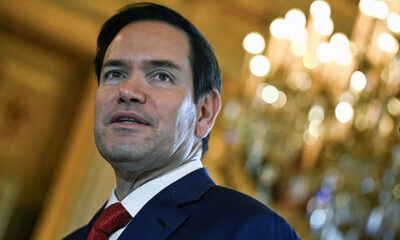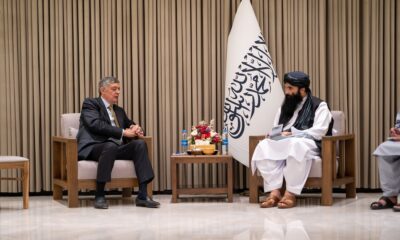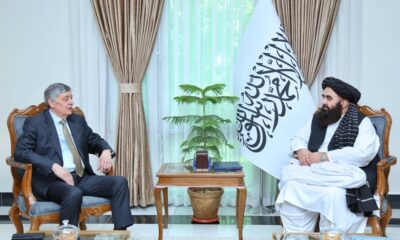World
Trump signs order aimed at dismantling US Department of Education
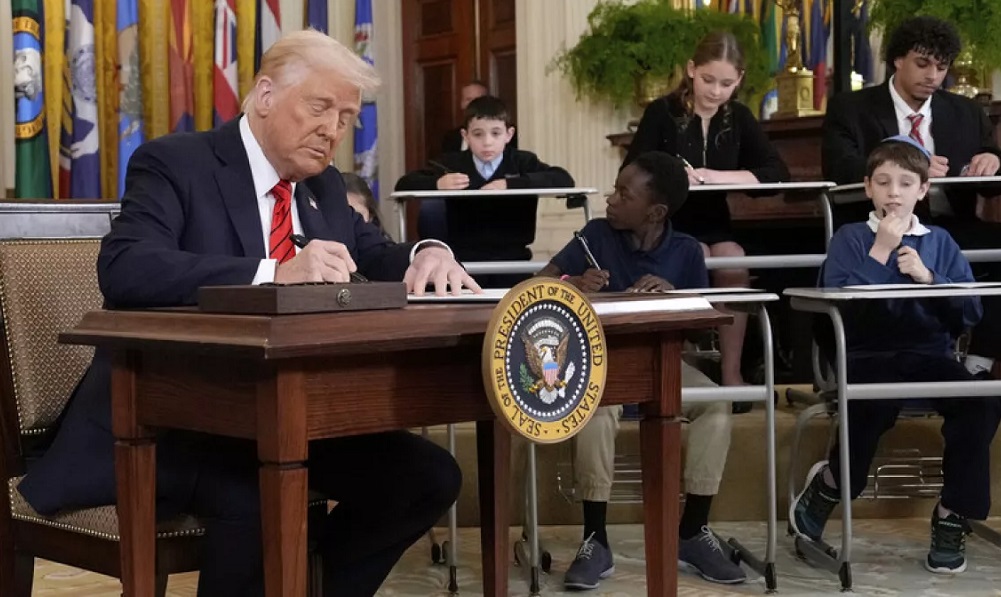
Flanked by students and educators, U.S. President Donald Trump on Thursday signed an executive order intended to essentially dismantle the federal Department of Education, making good on a longstanding campaign promise to conservatives.
The order is designed to leave school policy almost entirely in the hands of states and local boards, a prospect that alarms liberal education advocates, Reuters reported.
Thursday’s order was a first step “to eliminate” the department, Trump said at a signing ceremony in the East Room of the White House. Shuttering the agency completely requires an act of Congress, and Trump lacks the votes for that.
“We’re going to be returning education, very simply, back to the states where it belongs,” said Trump in front of a colorful backdrop of state flags.
Young students invited to the event sat at classroom desks encircling the president and signed their own mock executive orders alongside him.
The signing followed the department’s announcement last week that it would lay off nearly half of its staff, in step with Trump’s sweeping efforts to reduce the size of a federal government he considers to be bloated and inefficient.
Education has long been a political lightning rod in the United States. Conservatives favor local control over education policy and school-choice options that help private and religious schools, and left-leaning voters largely support robust funding for public schools and diversity programs.
But Trump has elevated the fight to a different level, making it part of a generalized push against what conservatives view as liberal indoctrination in America’s schools from the university level down to K-12 instruction.
He has sought to re-engineer higher education in the United States by reducing funding and pushing to eliminate diversity, equity and inclusion policies at colleges and universities, just as he has in the federal government.
Columbia University, for example, faced a Thursday deadline to respond to demands to tighten restrictions on campus protests as preconditions for opening talks on restoring $400 million in suspended federal funding.
The White House also argues the Education Department is a waste of money, citing mediocre test scores, disappointing literacy rates and lax math skills among students as proof that the return on the agency’s trillions of dollars in investment was poor.
Local battles over K-12 curricula accelerated during the coronavirus pandemic, which saw parents angrily confront officials at school board meetings nationwide. It was a discontent that Trump, other Republican candidates and conservative advocacy groups such as Moms for Liberty tapped into.
Trump was joined at the ceremony by Republican governors such as Greg Abbott of Texas and Ron DeSantis of Florida.
Democrats acknowledged on Thursday that Trump could effectively gut the department without congressional action.
“Donald Trump knows perfectly well he can’t abolish the Department of Education without Congress – but he understands that if you fire all the staff and smash it to pieces, you might get a similar, devastating result,” U.S. Senator Patty Murray said in a statement.
SEEKING CLOSURE
Trump suggested on Thursday that he will still seek to close down the department entirely, and that he wants Education Secretary Linda McMahon, who attended the White House event, to put herself out of a job.
The department oversees some 100,000 public and 34,000 private schools in the United States, although more than 85% of public school funding comes from state and local governments. It provides federal grants for needy schools and programs, including money to pay teachers of children with special needs, fund arts programs and replace outdated infrastructure.
It also oversees the $1.6 trillion in student loans held by tens of millions of Americans who cannot afford to pay for college outright.
For now, Trump’s executive order aims to whittle the department down to basic functions such as administering student loans, Pell Grants that help low-income students attend college and resources for children with special needs.
“We’re going to shut it down and shut it down as quickly as possible,” Trump said. “It’s doing us no good.”
Though Republicans control both chambers of Congress, Democratic support would be required to achieve the needed 60 votes in the Senate for such a bill to pass. At the event, Trump said the matter may ultimately land before Congress in a vote to do away with the department entirely.
Trump has acknowledged that he would need buy-in from Democratic lawmakers and teachers’ unions to fulfill his campaign pledge of fully closing the department. He likely will never get it.
“See you in court,” the head of the American Federation of Teachers union, Randi Weingarten, said in a statement.
A majority of the American public do not support closing the department.
A Reuters/Ipsos poll found last month that respondents opposed shuttering the Department of Education by roughly two to one – 65% to 30%. The Reuters/Ipsos poll, which was conducted online and nationwide, surveyed 4,145 U.S. adults and its results had a margin of error of about 2 percentage points.
Federal aid tends to flow more to Republican-leaning states than Democratic ones. It accounted for 15% of all K-12 revenue in states that voted for Trump in the 2024 election, compared with 11% of revenue in states that voted for his Democratic rival Kamala Harris, according to a Reuters analysis of Census Bureau data.
Two programs administered by the Department of Education — aid for low-income schools and students with special needs — are the largest of those federal aid programs.
World
Ukraine ready to hold talks with Russia once ceasefire in place, Zelenskiy says
Zelenskiy said he would be happy to meet U.S. President Donald Trump later this week when they attend the funeral of Pope Francis along with other world leaders.
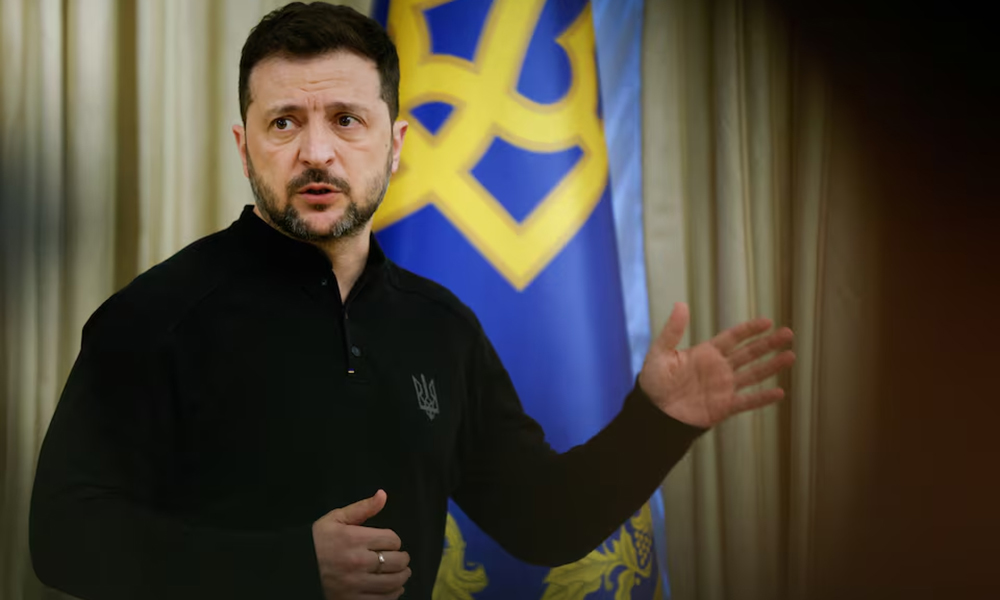
President Volodymyr Zelenskiy said on Tuesday that Ukraine would be ready to hold talks with Russia in any format once a ceasefire deal is in place and the fighting has stopped, Reuters reported.
The Ukrainian leader also told reporters at a briefing that a Ukrainian delegation meeting officials from Western countries in London on Wednesday would have a mandate to discuss a full or partial ceasefire.
“We are ready to record that after a ceasefire, we are ready to sit down in any format so that there are no dead ends,” Zelenskiy said in the presidential office in Kyiv.
“It will not be possible to agree on everything quickly,” he warned, noting numerous highly complex issues such as territory, security guarantees and Ukraine’s membership in the NATO military alliance.
He said that Ukraine would not recognise Moscow’s de jure control of the peninsula of Crimea as part of any deal as such a move would go against the Ukrainian constitution. Russia seized Crimea in 2014 and later annexed it.
Ukraine, he said, would be ready to partner with the United States to restore the work of the vast, Russian-occupied Zaporizhzhia nuclear power plant. There had been no such formal proposal from Washington about that, however, he added.
The talks in London, which are set to bring together officials from the United States, Britain, France, Germany and Ukraine, come amid a flurry of U.S.-led diplomatic efforts to find a way to end Russia’s war with Ukraine, read the report.
In an apparent change of plan, U.S. Secretary of State Marco Rubio will not be attending the talks in London, a State Department spokesperson said on Tuesday, adding that Washington’s Ukraine envoy General Keith Kellogg would attend.
Zelenskiy said he would be happy to meet U.S. President Donald Trump later this week when they attend the funeral of Pope Francis along with other world leaders.
Ukraine, Zelenskiy said, would also step up its diplomatic outreach this week and that he would meet South African President Cyril Ramaphosa, as well as the leaders of Spain, Poland and the Czech Republic.
World
Putin says he is open to direct peace talks with Ukraine
Zelenskiy, in his nightly video address, said Ukraine stood by its proposal for an end to attacks on civilian targets and was ready for any form of discussion to achieve it.

Russian President Vladimir Putin proposed on Monday bilateral talks with Ukraine for the first time since the early days of the war, and his Ukrainian counterpart Volodymyr Zelenskiy said Kyiv was eager to discuss a halt to attacks on civilian targets, Reuters reported.
While Zelenskiy did not respond directly to Putin’s proposal, he emphasized in his nightly video address that Ukraine “was ready for any conversation” about a ceasefire that would stop strikes on civilians.
The two leaders face pressure from the United States, which has threatened to walk away from its peace efforts unless some progress is achieved.
Russia and Ukraine have said they are open to further ceasefires after a 30-hour Easter truce declared by Moscow at the weekend. Each side accused the other of violating it.
Ukraine will take part in talks with the U.S. and European countries on Wednesday in London, Zelenskiy said. The discussions are a follow-up to a Paris meeting last week where the U.S. and European states discussed ways to end the more than three-year-old war, read the report.
Putin, speaking to a Russian state TV reporter, said fighting had resumed after the Easter ceasefire, which he announced unilaterally on Saturday. And Moscow, he said, was open to any peace initiatives and expected the same from Kyiv.
“We have always talked about this, that we have a positive attitude towards any peace initiatives. We hope that representatives of the Kyiv regime will feel the same way,” Putin told state TV reporter Pavel Zarubin.
Kremlin spokesman Dmitry Peskov, quoted later by Interfax news agency, told reporters: “When the president said that it was possible to discuss the issue of not striking civilian targets, including bilaterally, the president had in mind negotiations and discussions with the Ukrainian side.”
There have been no direct talks between the two sides since the early weeks after Russia’s February 2022 invasion, Reuters reported.
Zelenskiy, in his nightly video address, said Ukraine stood by its proposal for an end to attacks on civilian targets and was ready for any form of discussion to achieve it. Previously, the U.S. and Ukraine had framed this as a 30-day ceasefire.
“Ukraine maintains its proposal not to strike at the very least civilian targets. And we are expecting a clear response from Moscow,” he said. “We are ready for any conversation about how to achieve this.”
He said the London talks “have a primary task: to push for an unconditional ceasefire. This must be the starting point.”
Zelenskiy had earlier on Monday said an unconditional ceasefire would be “followed by the establishment of a real and lasting peace”.
Washington has said it would welcome an extension of the weekend truce. Zelenskiy said continued Russian attacks during the Easter ceasefire showed Moscow was intent on prolonging the war, read the report.
Zelenskiy also said that Ukraine’s forces were instructed to continue to mirror the Russian army’s actions.
“The nature of Ukraine’s actions will remain symmetrical: ceasefire will be met with ceasefire, and Russian strikes will be met with our own in defence. Actions always speak louder than words,” he said on X.
U.S. President Donald Trump and Secretary of State Marco Rubio both said on Friday that Washington could abandon the peace talks without progress within days. Trump struck a more optimistic note Sunday, saying that “hopefully” the two sides would make a deal “this week”.
Russia’s demands include Ukraine ceding all the land Putin claims to have annexed and accepting permanent neutrality. Ukraine says that would amount to surrender and leave it undefended if Moscow attacks again.
“President Putin and the Russian side remain open to seeking a peaceful settlement. We are continuing to work with the American side and, of course, we hope that this work will yield results,” Peskov told reporters.
World
Pentagon chief Hegseth shared sensitive Yemen war plans in second Signal chat, source says
The revelations of a second Signal chat raise more questions about Hegseth’s use of an unclassified messaging system to share highly sensitive security details
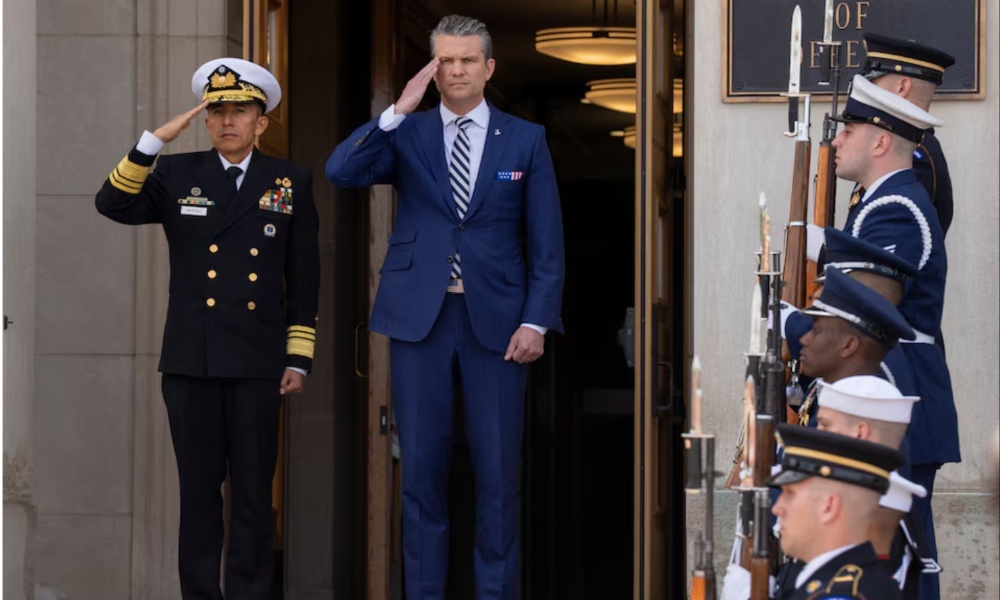
U.S. Defense Secretary Pete Hegseth shared details of a March attack on Yemen’s Iran-aligned Houthis in a message group that included his wife, brother and personal lawyer, a source familiar with the matter told Reuters on Sunday.
The revelations of a second Signal chat raise more questions about Hegseth’s use of an unclassified messaging system to share highly sensitive security details and come at a particularly delicate moment for him, with senior officials ousted from the Pentagon last week as part of an internal leak investigation.
In the second chat, Hegseth shared details of the attack similar to those revealed last month by The Atlantic magazine after its editor-in-chief, Jeffrey Goldberg, was included in a separate chat on the Signal app by mistake, in an embarrassing incident involving all of President Donald Trump’s most senior national security officials.
The person familiar with the matter, who was speaking on condition of anonymity, said the second chat included about a dozen people and was created during his confirmation process to discuss administrative issues rather than detailed military planning.
The chat included details of the schedule of the air strikes, the person said.
Hegseth’s wife, Jennifer, a former Fox News producer, has attended sensitive meetings with foreign military counterparts, according to images the Pentagon has publicly posted.
During a meeting Hegseth had with his British counterpart at the Pentagon in March, his wife could be seen sitting behind him.
Hegseth’s brother is a Department of Homeland Security liaison to the Pentagon.
The Trump administration has aggressively pursued leaks, an effort that has been enthusiastically embraced by Hegseth at the Pentagon.
Pentagon spokesperson Sean Parnell, without evidence, said that the media was “enthusiastically taking the grievances of disgruntled former employees as the sole sources for their article.”
“The Trump-hating media continues to be obsessed with destroying anyone committed to President Trump’s agenda. … We’ve already achieved so much for the American warfighter, and will never back down,” Parnell said in a statement on X.
White House spokesperson Anna Kelly said that “recently fired ‘leakers’ are continuing to misrepresent the truth to soothe their shattered egos and undermine the President’s agenda.
Democratic lawmakers said Hegseth could no longer stay in his job.
“We keep learning how Pete Hegseth put lives at risk,” Senate Minority Leader Chuck Schumer said in a post to X. “But Trump is still too weak to fire him. Pete Hegseth must be fired.”
Senator Tammy Duckworth, an Iraq War veteran who suffered grave injuries in combat in 2004, said that Hegseth “must resign in disgrace.”
A U.S. official at the Pentagon questioned how Hegseth could keep his job after the latest news.
The latest revelation comes days after Dan Caldwell, one of Hegseth’s leading advisers, was escorted from the Pentagon after being identified during an investigation into leaks at the Department of Defense.
Although Caldwell is not as well known as other senior Pentagon officials, he has played a critical role for Hegseth and was named as the Pentagon’s point person by the Secretary in the first Signal chat.
“We are incredibly disappointed by the manner in which our service at the Department of Defense ended,” Caldwell posted on X on Saturday. “Unnamed Pentagon officials have slandered our character with baseless attacks on our way out the door.”
Following Caldwell’s departure, less-senior officials Darin Selnick, who recently became Hegseth’s deputy chief of staff, and Colin Carroll, who was chief of staff to Deputy Defense Secretary Steve Feinberg, were put on administrative leave and fired on Friday. – REUTERS
-

 Sport5 days ago
Sport5 days agoAfghanistan qualify for U19 Cricket World Cup 2026
-
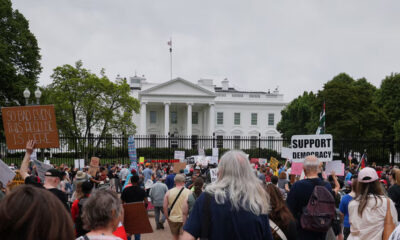
 World4 days ago
World4 days agoThousands of protesters rally against Trump across US
-
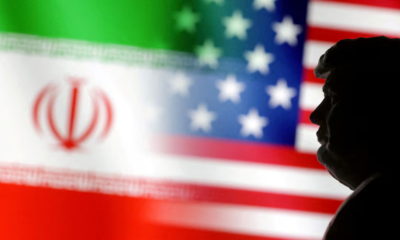
 World5 days ago
World5 days agoIran, US end nuclear talks in Rome, agree to meet next week
-

 Latest News4 days ago
Latest News4 days agoPolio vaccination campaign launched in Afghanistan
-

 International Sports4 days ago
International Sports4 days agoIPL 2025: 14-year-old Vaibhav Suryavanshi becomes youngest IPL player
-

 International Sports2 days ago
International Sports2 days agoIPL 2025: Robo-Dog ‘Champak’ explained
-

 Latest News3 days ago
Latest News3 days agoChina invites various Afghan delegations to attend Shanghai forums
-

 Latest News3 days ago
Latest News3 days agoAriana Afghan Airlines increases flights to China






